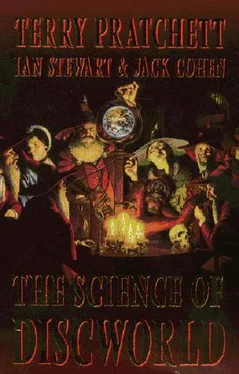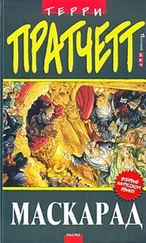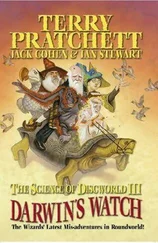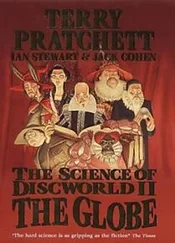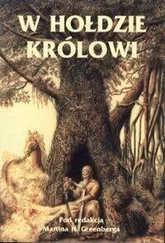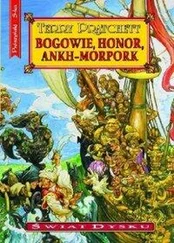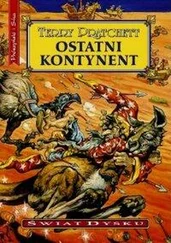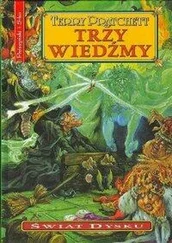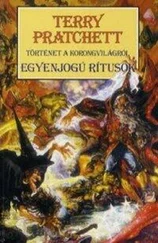Terry Pratchett - Science of Discworld
Здесь есть возможность читать онлайн «Terry Pratchett - Science of Discworld» весь текст электронной книги совершенно бесплатно (целиком полную версию без сокращений). В некоторых случаях можно слушать аудио, скачать через торрент в формате fb2 и присутствует краткое содержание. Жанр: Фантастика и фэнтези, на английском языке. Описание произведения, (предисловие) а так же отзывы посетителей доступны на портале библиотеки ЛибКат.
- Название:Science of Discworld
- Автор:
- Жанр:
- Год:неизвестен
- ISBN:нет данных
- Рейтинг книги:4 / 5. Голосов: 1
-
Избранное:Добавить в избранное
- Отзывы:
-
Ваша оценка:
- 80
- 1
- 2
- 3
- 4
- 5
Science of Discworld: краткое содержание, описание и аннотация
Предлагаем к чтению аннотацию, описание, краткое содержание или предисловие (зависит от того, что написал сам автор книги «Science of Discworld»). Если вы не нашли необходимую информацию о книге — напишите в комментариях, мы постараемся отыскать её.
Science of Discworld — читать онлайн бесплатно полную книгу (весь текст) целиком
Ниже представлен текст книги, разбитый по страницам. Система сохранения места последней прочитанной страницы, позволяет с удобством читать онлайн бесплатно книгу «Science of Discworld», без необходимости каждый раз заново искать на чём Вы остановились. Поставьте закладку, и сможете в любой момент перейти на страницу, на которой закончили чтение.
Интервал:
Закладка:
Starting from an enormous range of observations of many species of plants and animals, Darwin had become convinced that organisms could change of their own accord, so much so that they could even, over very long periods, change so much that they gave rise to new species.
Imagine a lot of creatures of the same species. They are in competition for resources, such as food, competing with each other, and with animals of other species. Now suppose that by random chance, one or more of these animals has offspring that are better at winning the competition. Then those animals are more likely to survive for long enough to produce the next generation, and the next generation is also better at winning. In contrast, if one or more of these animals has offspring that are worse at winning the competition, then those animals are less likely to produce a succeeding generation, and even if they somehow do, that next generation is still worse at winning. Qearly even a tiny advantage will, over many generations, lead to a population composed almost entirely of the new high-powered winners. In fact, the effect of any advantage grows like compound interest, so it doesn't take all that long. Natural selection sounds like a very straightforward idea, but words like 'competition' and 'win' are loaded. It's easy to get the wrong impression of just how subtle evolution must be. When a baby bird falls out of the nest and gets gobbled up by a passing cat, it is easy to see the battle for survival as being fought between bird and cat. But if that is the competition, then cats are clear winners, so why haven't birds evolved away altogether? Why aren't there just cats?
Because cats and birds long ago came, unwittingly, to a mutual accommodation in which both can survive. If birds could breed unchecked, there would soon be far too many birds for their food supply to support them. A female starling, for instance, lays about 16 eggs in her life. If they all survived, and this continued, the starling population would multiply by eight every generation, 16 babies for every two parents. Such 'exponential' growth is amazingly rapid: by the 70th generation a sphere the size of the solar system would be occupied entirely by starlings (instead of by pigeons, which appears to be its natural destiny).
The only 'growth rate' for the population that works is for each breeding pair of adult starlings to produce, on average, exactly one breeding pair of adult starlings. Replacement, but no more, and no less. Anything more than replacement, and the population explodes; anything less, and it eventually dies out. So of those 16 eggs, an average of 14 must not survive to breed. And that's where the cat comes in, along with all the other things that make it tough to be a bird, especially a young one. In a way, the cats are doing the birds a favour, collectively, though maybe not as individuals. (It depends if you're one of the two that survive to breed or the 14 that don't.)
Rather more obviously, the birds are doing the cats a favour, cat food literally drops out of the skies, manna from heaven. So what stops it getting out of hand is that if a group of greedy cats happens to evolve somewhere, they rapidly eat themselves out of existence again. The more restrained cats next door survive to breed, and quickly take over the vacated territory. So those cats that eat just enough birds to maintain their food supply will win a competition against the greedy cats. Cats and birds aren't competing because they're not playing the same game. The real competitions are between cats and other cats, and between birds and other birds. This may seem a wasteful process, but it isn't. A female starling has no trouble laying her 16 eggs. Life is reproductive, it makes reasonably close, though not exact, copies of itself, in quantity, and 'cheaply'. Evolution can easily 'try out' many different possibilities, and discard those that don't work. And that's an astonishingly effective way to home in on what does work.
As Huxley said, it's such an obvious idea. It caused so much trouble from religionists because it takes the gloss off one of their favourite arguments, the argument from design. Living creatures seem so perfectly put together that surely they must have been designed, and if so, there must have been a Designer. Darwinism made it clear that a process of random, purposeless variation trimmed by self-induced selection can achieve equally impressive results, so there can be the semblance of design without any Designer.
There are plenty of details to Darwinism that still aren't understood, as with all science, but most of the obvious ways of trying to shoot it down have been answered effectively. The classic example -still routinely trotted out by creationists and others even though Darwin himself had a pretty good answer, is the evolution of the eye. The human eye is a complex structure, and all of its components have to fit together to a high degree of accuracy, or it won't work. If we claim that such a complex structure has evolved, we must accept that it evolved gradually. It can't all have come into being at once. But if so, then at every stage along the evolutionary track the still-evolving proto-eye must offer some kind of survival advantage to the creature that possesses it. How can this happen? The question is often asked in the form 'What use is half an eye?', to which you are expected to conclude 'nothing', followed by a rapid conversion to some religion or other. 'Nothing' is a reasonable answer, but to the wrong question. There are lots of ways to get to an eye gradually that do not require it to be assembled piece by piece like a jigsaw puzzle. Evolution does not build creatures piece by piece like the God of Evolution in The Last Continent. Darwin himself pointed out that in creatures alive in his day you could find all kinds of light-sensitive organs, starting with patches of skin, then increasing in complexity, light-gathering power, and ability to detect fine detail, right up to structures as sophisticated as the human eye. There is a continuum of eyelike organs in the living world, and every creature gains an advantage by having its own type of light-sensing device, in comparison to similar creatures that have a slightly less effective device of a similar kind.
In 1994 Daniel Nilsson and Susanne Pelger used a computer to see what would happen to a mathematical model of a light-sensing surface if it was allowed to change in small, random, biologically feasible ways, with only those changes that improved its sensitivity to light being retained. They found that within 400,000 generations, an evolutionary blink of an eye, that flat surface gradually changed into a recognizable eye, complete with a lens. The lens even bent light differently in different places, just like our eye and unlike normal spectacle lenses. At every tiny step along the way, a creature with the improved 'eye' would be better than those with the old version.
At no stage was there ever 'half an eye'. There were just light-sensing things that got better at it.
Since the 1950s, we have been in possession of a new and central piece of the evolutionary jigsaw, one that Darwin would have given his right arm to know about. This is the physical, more precisely, chemical, nature of whatever it is that ensures that characteristics of organisms can change and be passed from one generation to the next.
You know the word: gene.
You know the molecule: DNA.
You even know how it works: DNA carries the genetic code, a kind of chemical 'blueprint' for an organism.
And, probably, a lot of what you know is lies-to-children.
Just as 'survival of the fittest' captured the imaginations of the Victorians, so 'DNA' has captured the imaginations of today's public. However, imaginations thrive best if they are left free to roam: they grow tired and feeble in captivity. Captive imaginations do breed quite effectively, because they are protected from the terrible predator known as Thought.
Читать дальшеИнтервал:
Закладка:
Похожие книги на «Science of Discworld»
Представляем Вашему вниманию похожие книги на «Science of Discworld» списком для выбора. Мы отобрали схожую по названию и смыслу литературу в надежде предоставить читателям больше вариантов отыскать новые, интересные, ещё непрочитанные произведения.
Обсуждение, отзывы о книге «Science of Discworld» и просто собственные мнения читателей. Оставьте ваши комментарии, напишите, что Вы думаете о произведении, его смысле или главных героях. Укажите что конкретно понравилось, а что нет, и почему Вы так считаете.
